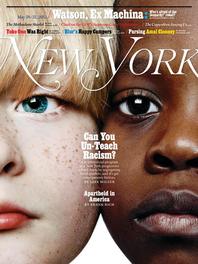|
In an airport lounge recently, I found myself with time to kill and US dollars to spend. Right away a magazine in the gift shop caught my eye, with this cover: “CAN YOU UN-TEACH RACISM”? What a bold question. I picked up the magazine and read the article before I even made it to my gate. Race issues in the States and Canada recently have been getting a lot of media attention. Here in Canada, this Desmond Cole piece against police carding sparked some debate in my personal and professional circles. Talking about race is difficult, and can be very frustrating. Race issues also don't seem to be discussed in an informed way. So when I came across this piece, quotes like the following really resonated: The education that many of us have received about race has not been adequate. Hence, where are we as a nation? We are trying to pioneer... to see if we can get it right. - Damian Fernandez At Fieldston Lower, a private elementary school in the Bronx, New York, a controversial program was launched in 2015. The program involves dividing kids starting in grade three (age 8), into racial “affinity groups”. They meet once a week for five weeks to discuss issues of race, and come together in a larger group to discuss their feelings and findings. Fieldston has a reputation of being a very progressive, liberal school, with a diverse student body. So when the form came home for students to choose an affinity group, reactions from parents and students were divided on whether or not this program was a good idea, with opinions ranging from strong negative reactions to this "forced segregation", to those in strong support. Although optional affinity programs are in place in many schools across the US, at Feldston, this is a mandatory program, for all kids, including those who identify as white. At Feldston, parents who were most adamantly opposed to the program tended to be people who would be categorized as politically liberal, and white. The reluctance to discuss issues of race doesn't start in adulthood though. Tufts psychologists have shown that as early as age 10, white children show a strong discomfort talking about race; they’d rather stay silent than speak about race aloud. This discomfort is one that I’ve noticed here in Toronto amongst adults, in one of the most diverse cities in the world. Recently, at brunch, I shared some of this experience with an equity educator based in New York. She shared a tool she uses in facilitating conversations about race, explaining that there are four ways to enter conversations about race: from an emotional, moral, intellectual, or social/relational standpoint. As people become aware of these four entry points, we can work towards having more balanced conversations about race. It is also helpful to identify where others are coming from in order to have a more productive (and less defensive) conversation.
As an educator, I’m not comfortable judging the affinity group program unless I see the details of implementation. What I do appreciate though, is that the school is taking concrete steps to have these conversations; to allow children to discuss issues that are often masked or labeled as taboo. The more options we have to bring these issues into our classrooms, the better the outlook for our schools and societies to truly work towards more equity. Links: - See the full NY Mag article here (excellent read!) - Teaching Tolerance (A resource hub with free resources for educators): http://www.tolerance.org/ - Courageous conversations about race: A field guide for achieving equity in schools (Book available on amazon)
0 Comments
Leave a Reply. |
Categories
All
AuthorA passionate educator.. on a quest for a schooling model to love! Archives
August 2017
|



 RSS Feed
RSS Feed
